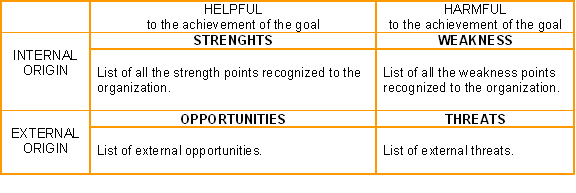Difference between revisions of "SWOT Analysis"
From Learning and training wiki
Chantal joly (Talk | contribs) |
Chantal joly (Talk | contribs) |
||
| Line 10: | Line 10: | ||
#'''Opportunity''' : An external possibility that an organization can pursue or exploit to gain benefit. For example : market developments, competitors' vulnerabilities, information and research. The aim of the Swot is to prioritise and optimise. | #'''Opportunity''' : An external possibility that an organization can pursue or exploit to gain benefit. For example : market developments, competitors' vulnerabilities, information and research. The aim of the Swot is to prioritise and optimise. | ||
#'''Threat''' : An external factor that has the potential to reduce an organization's performance. For example : political and environmental effects, market demand, IT developments. The aim of the Swot is to counter. | #'''Threat''' : An external factor that has the potential to reduce an organization's performance. For example : political and environmental effects, market demand, IT developments. The aim of the Swot is to counter. | ||
| + | |||
| + | Strengths and opportunities are are identified as enhancers to desired performance, while weaknesses and threats are inhibitors. | ||
<ref>[http://www.businessballs.com www.businessballs.com] (03 October 2008), http://web.worldbank.org web.worldbank.org</ref> | <ref>[http://www.businessballs.com www.businessballs.com] (03 October 2008), http://web.worldbank.org web.worldbank.org</ref> | ||
Revision as of 10:10, 6 October 2008
| A tool that identifies the Strengths, Weaknesses, Opportunities and Threats of an organization. Specifically, SWOT is a basic, straightforward model that assesses what an organization can and cannot do as well as its potential opportunities and threats. The method of SWOT analysis is to take the information from an environmental analysis and separate it into internal (strengths and weaknesses) and external issues (opportunities and threats). Once this is completed, SWOT analysis determines what may assist the organization in accomplishing its objectives, and what obstacles must be minimized to achieve desired results. [1] |
|
Headings
Strengths and opportunities are are identified as enhancers to desired performance, while weaknesses and threats are inhibitors.
Step by Step
SWOT MatrixJob Aids |
References
- ↑ www.answers.com (20 August 2008), www.netmba.com (20 August 2008), en.wikipedia.org (20 August 2008)
- ↑ www.businessballs.com (03 October 2008), http://web.worldbank.org web.worldbank.org
- ↑ www.quickmba.com (13 August 2008), Wikipedia (13 August 2008), Project Cycle Management Guidelines, European Commission, 2004
